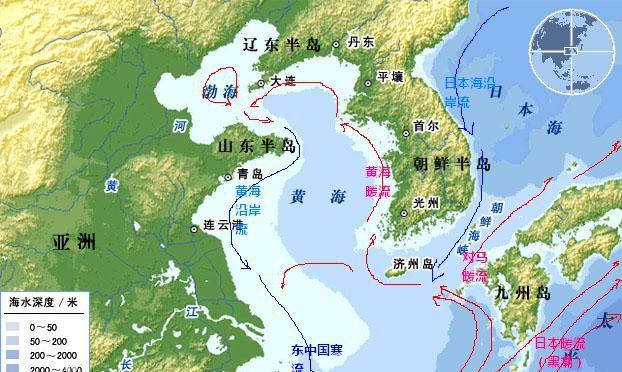Kuroshio, also known as the Japanese Warm Current, the strongest warm current in the western North Pacific, is formed by the North Equatorial Warm Current turning north on the east coast of the Philippine Islands, the mainstream flows north along the east coast of Taiwan Island and the west side of the Ryukyu Islands, directly to the southeast coast of the Japanese Archipelago, and is about 100-200 kilometers wide and 400 meters deep in the sea east of Taiwan Island; the maximum flow rate is 60-90 kilometers per day and night, to 40º north latitude, nearby and the Thousand Islands Cold Current meets, under the prevailing west wind, and then turns east to become the North Pacific Warm Current.

The sea flow measured off the headlands of Shikoku Island in Japan amounted to 65 million cubic meters per second, which is about 360 times the flow of the Amazon River, the world's largest flow. The average annual water temperature in Kuroshio is about 24 to 26 degrees Celsius, about 18 to 24 degrees Celsius in winter, and 22 to 30 degrees Celsius in summer. Kuroshio is also 7 to 10 degrees Celsius higher than the neighboring Yellow Sea, and 20 degrees Celsius higher in winter. The mainstream of Kuroshio flows not along the edge of the East Asian continent, but along the East Asian island arc, so the influence of the kuroshio on the island arc is also more significant than that of the mainland.
Kuroshio is the northward branch of the Pacific North Equatorial Warm Current after meeting the mainland, is a link of the Pacific Warm Current, and is the second largest warm current in the world, only after the Gulf Of Mexico Warm Current. There are three factors in its formation: First, the warm northern equatorial current meets the mainland and deflects northward. Second, the blowing of the summer ocean wind and the southwest wind formed by the southeast trade wind crossing the equator. Third, the influence of the geostrophic deflection force.
The Japan Warm Current is the backbone of the entire East China Sea circulation and has a significant impact on the hydro-meteorological conditions in this sea area, starting from the Philippines, passing through the eastern waters of Taiwan, flowing northeast along Japan, and merging into the eastward North Pacific Warm Current after encountering the pro-tide. Kuroshio brings warm waters from the tropics to the cold Arctic seas, warming the icy polar waters to a temperature suitable for life.
Kuroshio's flow rate is quite fast, like a highway, providing a quick and easy path for migratory fish to head north, so that a considerable number of migratory fish can be caught in the black tide, and other large fish attracted by these fish to feed.